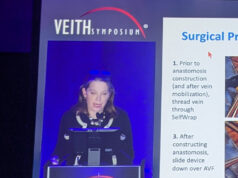
A retrospective analysis of the US Renal Data System has found that, in patients undergoing haemodialysis treatment, a higher degree of frailty is associated with an increased timeframe for a vascular access to become functional. As such, writing in the American Journal of Kidney Diseases (AJKD), the analysis’ authors conclude that “frailty may be useful for informing clinical decision-making regarding choice of vascular access”.
The authors—Karen Woo (David Geffen School of Medicine at UCLA [University of California, Los Angeles], Los Angeles, USA) et al—begin by noting that frailty is defined as “a clinically recognisable state of increased vulnerability resulting from ageing-associated decline in reserve and function across multiple physiologic systems, such that the ability to cope with everyday or acute stressors is compromised”. They further claim that, despite the high prevalence of frailty among dialysis patients (with more than 75% of patients older than 60 years of age receiving maintenance dialysis for kidney failure meeting the criteria for frailty), it is unknown whether frailty is directly associated with vascular access failure.
As such, they set out to elucidate the link between frailty and the time to a mature access via a retrospective, observational study. The study involved patients who initiated haemodialysis through a tunnelled catheter in the US Renal Data System database, from January 2012 through October 2017, and underwent subsequent creation of an arteriovenous fistula or graft. The investigators followed patients from the placement of their first fistula or graft (time zero) to functional use of the access.
The primary regressor of interest, Woo et al detail, was frailty—measured using a claims-based frailty indicator (CFI). This was calculated by modifying a validated, claims-based disability status model created specifically for dialysis populations and “anchored to a well-described frailty phenotype”, the authors add. The CFI yields a continuous value from zero to one, with higher scores indicating greater frailty. The main outcomes assessed in the analysis were overall fistula/graft survival time, and the elapsed time between baseline period (placement of the fistula or graft) and functional use (initiation of haemodialysis using the index vascular access with two needles).
A total of 41,471 patients (aged ≥65 years) met the study’s inclusion criteria including 33,212 who received a fistula, and 8,259 who received a graft, after initiating dialysis. Among those who underwent fistula creation, functional use of the fistula was achieved within the observation period in 18,895 patients (57%), compared with 5,604 patients (68%) in the graft group. The mean CFI score for the entire patient population was 0.17.
Regarding their results, the researchers report that higher CFI quartiles were associated with a greater rate of mortality, adding that patients in the highest CFI quartile had more than two times the rate of mortality compared with patients in the lowest CFI quartile (hazard ratio [HR]=2.49 [95% CI, 2.41–2.58]). And, in multivariable analyses, the highest CFI quartile was significantly associated with longer time to functional use of fistulas (HR=0.65 [95% CI, 0.62–0.69]) and grafts (HR=0.88 [95% CI, 0.79–0.98]).
Woo et al also note that, in their analysis, increased patient frailty was associated with a lower likelihood of functional fistula usage in a dose-response manner, but that the association between frailty and a lower likelihood of functional graft usage was seen only in the highest CFI quartile. “This is not surprising,” they continue, “because the physiologic processes required for fistula maturation can be negatively affected by frailty.”
They also claim the results of their study further emphasise the importance of individualising vascular access decision-making based on specific patient characteristics—particularly following recent shifts from ‘fistula-first’ regimes to more patient-centred approaches in clinical practice guidelines. Moving on to discuss wider implications in terms of US reimbursement policies, they add: “Our results suggest that frailty should be an important consideration in designing these payment models, and many patients, particularly those in the highest frailty quartiles, would not experience the putative benefits of a fistula-first policy.”
In addition, Woo et al detail key limitations of their study—including reduced generalisability due to the requirement of 12 months of Medicare claims availability before initiation of dialysis, and a lack of patient-specific sociodemographic data and data on patient anatomic/surgeon characteristics. The authors conclude their AJKD report by stating: “Frailty, if measured in a systematic clinical assessment, could be used to guide vascular access decision-making, and future studies of vascular access outcomes should include assessment of frailty. Efforts to identify an effective predictive model of fistula maturation failure should be continued.”












